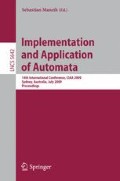Abstract
State elimination is an intuitive and easy-to-implement algorithm that computes a regular expression from a finite-state automaton (FA). The size of a regular expression from state elimination depends on the state removal sequence. Note that it is very hard to compute the shortest regular expression for a given FA in general and we cannot avoid the exponential blow-up from state elimination. Nevertheless, we notice that we may have a shorter regular expression if we choose a good removal sequence. This observation motivates us to examine heuristics based on the structural properties of an FA and implement state elimination using the heuristics that run in polynomial time. We demonstrate the effectiveness of our algorithm by experiments.
Access this chapter
Tax calculation will be finalised at checkout
Purchases are for personal use only
Preview
Unable to display preview. Download preview PDF.
References
Brüggemann-Klein, A., Wood, D.: One-unambiguous regular languages. Information and Computation 140, 229–253 (1998)
Brzozowski, J., McCluskey Jr., E.: Signal flow graph techniques for sequential circuit state diagrams. IEEE Transactions on Electronic Computers EC-12, 67–76 (1963)
Delgado, M., Morais, J.: Approximation to the smallest regular expression for a given regular language. In: Domaratzki, M., Okhotin, A., Salomaa, K., Yu, S. (eds.) CIAA 2004. LNCS, vol. 3317, pp. 312–314. Springer, Heidelberg (2005)
Ellul, K., Krawetz, B., Shallit, J., Wang, M.-W.: Regular expressions: New results and open problems. Journal of Automata, Languages and Combinatorics 9, 233–256 (2004)
Glushkov, V.: The abstract theory of automata. Russian Mathematical Surveys 16, 1–53 (1961)
Gruber, H., Holzer, M.: Provably shorter regular expressions from deterministic finite automata. In: Ito, M., Toyama, M. (eds.) DLT 2008. LNCS, vol. 5257, pp. 383–395. Springer, Heidelberg (2008)
Gulan, S., Fernau, H.: Local elimination-strategies in automata for shorter regular expressions. In: Proceedings of SOFSEM 2008, pp. 46–57 (2008)
Han, Y.-S., Wood, D.: Obtaining shorter regular expressions from finite-state automata. Theoretical Computer Science 370(1-3), 110–120 (2007)
Hopcroft, J., Ullman, J.: Introduction to Automata Theory, Languages, and Computation, 2nd edn. Addison-Wesley, Reading (1979)
Jiang, T., Ravikumar, B.: Minimal NFA problems are hard. SIAM Journal on Computing 22(6), 1117–1141 (1993)
Kleene, S.: Representation of events in nerve nets and finite automata. In: Shannon, C., McCarthy, J. (eds.) Automata Studies, pp. 3–42. Princeton University Press, Princeton (1956)
McNaughton, R., Yamada, H.: Regular expressions and state graphs for automata. IEEE Transactions on Electronic Computers 9, 39–47 (1960)
Meyer, A., Stockmeyer, L.: The equivalence problem for regular expressions with squaring requires exponential time. In: Proceedings of the Thirteenth Annual IEEE Symposium on Switching and Automata Theory, pp. 125–129 (1972)
Moreira, N., Reis, R.: Series-parallel automata and short regular expressions. Fundamenta Informaticae (accepted for publication, 2009)
Rodger, S.H., Finley, T.W.: JFLAP: An Interactive Formal Languages and Automata Package. Jones & Bartlett Pub. (2006)
Thompson, K.: Regular expression search algorithm. Communications of the ACM 11, 419–422 (1968)
Wood, D.: Theory of Computation. John Wiley & Sons, Inc., New York (1987)
Author information
Authors and Affiliations
Editor information
Editors and Affiliations
Rights and permissions
Copyright information
© 2009 Springer-Verlag Berlin Heidelberg
About this paper
Cite this paper
Ahn, JH., Han, YS. (2009). Implementation of State Elimination Using Heuristics. In: Maneth, S. (eds) Implementation and Application of Automata. CIAA 2009. Lecture Notes in Computer Science, vol 5642. Springer, Berlin, Heidelberg. https://doi.org/10.1007/978-3-642-02979-0_21
Download citation
DOI: https://doi.org/10.1007/978-3-642-02979-0_21
Publisher Name: Springer, Berlin, Heidelberg
Print ISBN: 978-3-642-02978-3
Online ISBN: 978-3-642-02979-0
eBook Packages: Computer ScienceComputer Science (R0)

